Popcorn Hour C-300 Review
Popcorn Hour C-300
The ultimate media player box? We take a look at the Popcorn Hour flagship.
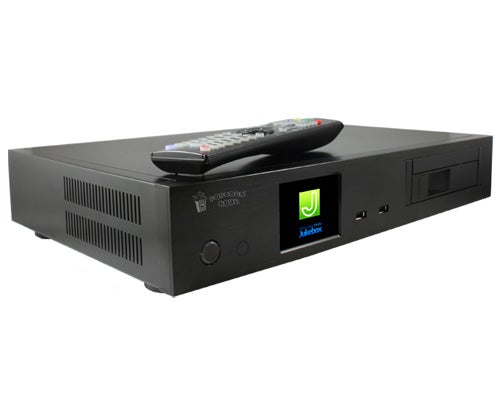
Verdict
Pros
- Excellent codec support
- Strong build
- Improved UI
Cons
- No Wi-Fi
- Expensive
- No iPlayer
- No Netflix
- No LoveFilm
Key Specifications
- Review Price: £341.00
- Easy-access 3.5in drive bay
- Wide video and audio codec support
- LAN port
- On-body display
- App store
Popcorn Hour is one of the biggest names in media boxes, made for those with gigantic collections of downloaded movies and TV shows. Yes, they’re popular among pirates, but the Popcorn Hour C-300’s claim to be able to play any video or audio file you can throw at it should appeal to at least a handful of other folk too.
An update to the C-200, this is the top-end model in the Popcorn Hour line-up. It’s big, versatile in at least a few senses and costs more than £300. And while capable in its field, missing features mean it simply isn’t worth if it you’re remotely legit.
Design
The Popcorn Hour C-300 is a serious-looking piece of kit. As long as an old-fashioned Hi-Fi separates system and with edges sharp enough to take an eye out, this is not a device to please partners and housemates who would complain about surround sound system wires littering the lounge.
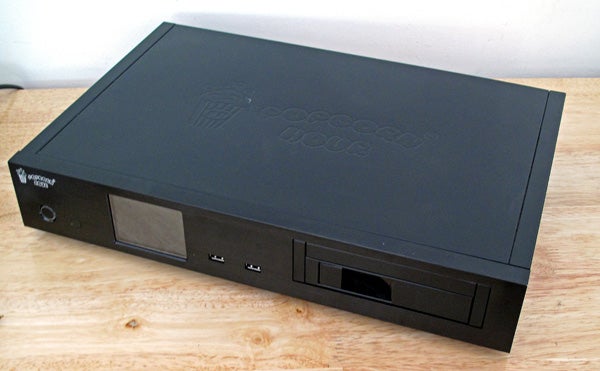
With an imposing black brushed metal front and an all-metal frame, it’s undoubtedly solid. But attractive? Not really. This is a box that largely trades gorgeous design for the practical needs of its intended audience – those with full-to-the-brim media libraries.
Connections
On its front are two unashamed, uncovered USB 2.0 ports, there to quickly stick pen drives into, and an easy release 3.5in/2.5in bay door. This lets you – quite literally – shove in a hard drive or Blu-ray player. At the end of the bay are the power and connector plugs waiting for their arrival. The Popcorn Hour C-300 doesn’t come with either drive as standard, though. 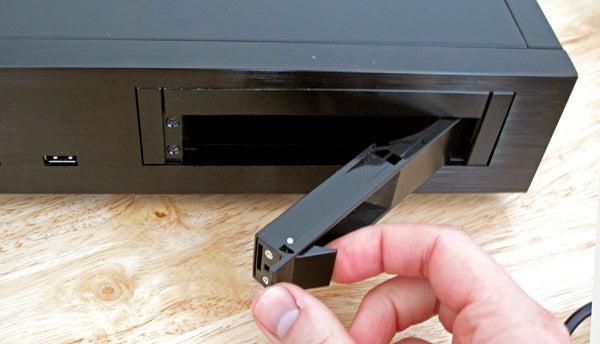
Having to spend more to unleash all of the box’s potential is a running theme of the Popcorn Hour C-300. Although it’s eye-wateringly expensive compared with some media boxes, such as the sub-£100 Western Digital TV Live, Wi-Fi does not come built-in. You’ll need to buy a £25 Popcorn Hour WN-160, which helpfully seem to be out of stock in the UK at present. We tried using a handful of non-official sticks but none worked.
Not willing to splash out on accessories? You have to use the LAN port on the C-300’s rear. Popcorn Hour and media enthusiasts may argue that a wired connection offers much better reliability and streaming quality, and they’re not wrong. But the idea that HD-quality streaming over Wi-Fi is impossible is wrong. And not everyone keeps their router in the lounge.
For a more reliable signal than the WN-160 Wi-Fi USB stick provides, Popcorn Hour also offers a three-antenna internal Wi-Fi card, the MN-200. Once again, though, it seems to be about as easy to get hold of as bigfoot’s phone number.
Also on the Popcorn Hour C-300’s rear are composite, S-video and component video outputs, coaxial, optical and phono audio outputs and – most likely to be used these days – an HDMI 1.4 port, which of course handle both audio and video. There are two additional USB 2.0 ports to plug-in drives, external hard drives or the Wi-Fi dongle. This is the same spread of audio/video ports as was seen in the C-200. But, then again, it’s all you need in a device like this.
The screen
The most important hardware change in this new generation is the 3.2in colour LCD on its front. For the first versions of the box’s firmware, this screen did precisely nothing, but with the latest it shows a cropped version of whatever’s on the main screen. We found it a bit of annoyance during normal usage, but it does enable skipping through a music library without turning your TV on. But isn’t peering into a teeny screen a bit antiquated in the days of AirPlay and other forms of wireless streaming? 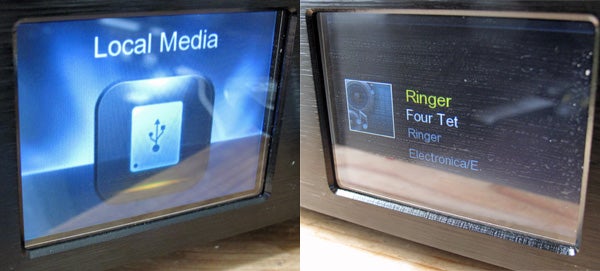
Popcorn Hour proves the point itself, offering an app for Android smartphones and iOS devices. However, it’s not free (£1.99) and doesn’t have a particularly slick interface.
Interface
Somewhat unimpressed by the front screen, the most important change the Popcorn Hour C-300 brings, compared to its predecessor, is a re-designed interface. The clunky and clumsy UI of the C-200 has been replaced with something much faster and more modern.
Its front-end is still fairly basic, however. The home screen is a horizontally-scrolling list of icons that lets you pick between basic types of content – local content, network-streamed stuff, apps and so on. Content is no longer split into video and music, which is an improvement over the Popcorn Hour experience of old. It’s fairly quick, reasonably attractive and has animated transitions to avoid the cheap, gloss-free feel of some media players. 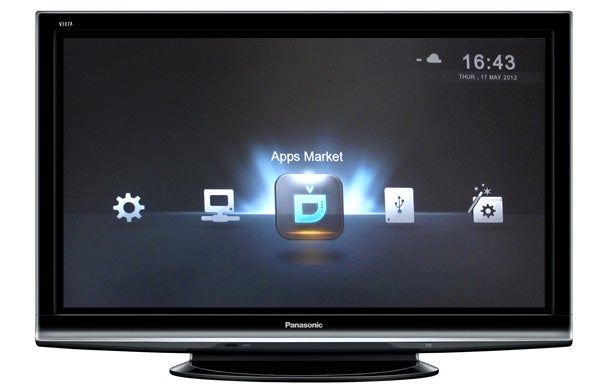
The main menu
However, stack it up next to something like the Boxee interface, or those of the Xbox 360 and PS3, and it looks pretty glum. There’s no customisation of how it looks, and while the Flash-based feel is fine, it lacks the fun, lifestyle-oriented vibe of some boxes more geared towards full streaming from services like iPlayer and Netflix than streaming movies from a NAS box full of nicked flicks.
If getting to your content quick is all you’re after, the Popcorn Hour C-300 performs pretty well, with quick reorganisation of inserted media and much snappier overall performance than oldie Popcorn Hour boxes. If you’re going to keep a largely static library of music and films on the box – you can also employ the neat Jukebox Manager software.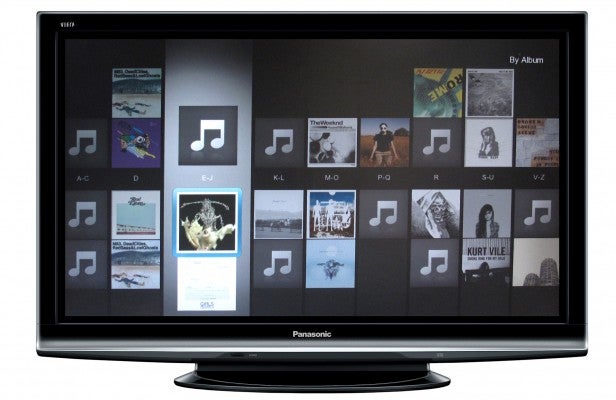
The Jukebox Manager UI looks great, but isn’t practical for all
This scans through your files and grabs artwork and additional information from the net, arranging it into a swish, image-led grid of covers. We found it works much better for films than music – powered by IMDb – but it roped-in music info just fine too. Ideally, we’d like to be able to boot to this view and see software clever enough to add new content on-the-fly, but as-is this interface isn’t really suitable for those using rapidly-growing or changing libraries, or those streamed from NAS drives – a shame.
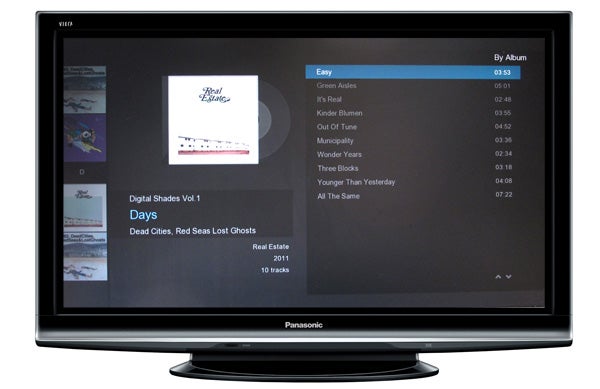
Codec support
Running an 800MHz Sigma Designs SMP8647 processor, the C-300’s numbers may not sound all that impressive, but this chip is more-than capable of playing virtually any video and audio file. All popular video codecs are supported, including the basics of MKV, Xvid and DivX, and more exotic types such as MKV3D with side-by-side and top/bottom 3D.
Of course, what’s actually more important than including headline-grabbing codecs like this is on-going support, with updates that will cater for any tweaks made to the main codecs. Between December 2011 and February 2012, Popcorn Hour maker Syabas released an update each month, but they seemed to have dried up since. However, in the past its product have been supported for at least a few years. 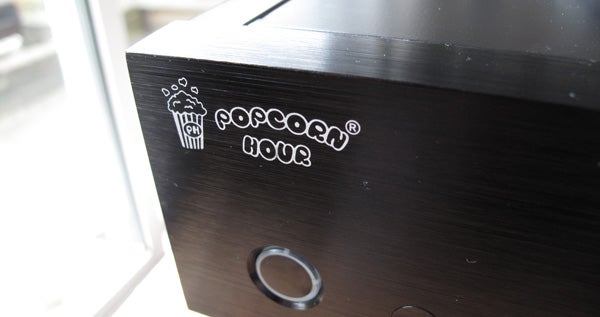
Music/audio support is also very good, with favourites like FLAC, APE in as well as the more common lossy types. For movie soundtracks, DTS and Dolby Digital decoders are in, while HD format pass-through is supported. Load one of the C-300’s internal bays (another is under the casing) with a Blu-ray drive and you have a pretty decent home cinema hub on your hands. It lets you correct audio sync issues too, which is helpful for correcting the delay caused by home cinema receivers, or problems with specific videos.
Performance
Image quality of the C-300 is excellent, with HD pictures looking supremely sharp and detailed. It also upscales content, but if you’re not going to be primarily watching HD content, we can think of few reasons to purchase as high-end a box as this.
There’s no fan inside the Popcorn Hour C-300 – it uses passive cooling instead. This means it’s more-or-less silent. That’s more than we can say of the Sony PS3, which is commonly used as a less-capable Popcorn Hour.
Streaming and Setup
If you’re a planning on using a hard drive or flash storage, the setup process of the Popcorn Hour C-300 is very easy – if a little nerve-wracking for those who haven’t taken a computer apart before. The front 3.5in bay is extremely easy to use, but the other is hidden under the casing. Aware that many will want to use every drive slot possible, Syabas has made it easy to get under the hood. There’s just a single screw holding on the metal lid. Adding a hard drive can be done in under five minutes.
Getting streaming setup is – as usual – much more likely to be fraught. The C-300 supports a wide array of streaming standards including Samba, UPnP and Windows Media Connect, but its approach to setup is relatively hands-off. There is a setup wizard within the box, but it only extends as far as the basics of getting online and setting the region/time info. Once again, Popcorn Hour C-300 is reasonably well-matched to the techy, Bit-torrent/Newsgroup crowd, but less “online 24/7” folk may find setup frustrating and confusing. 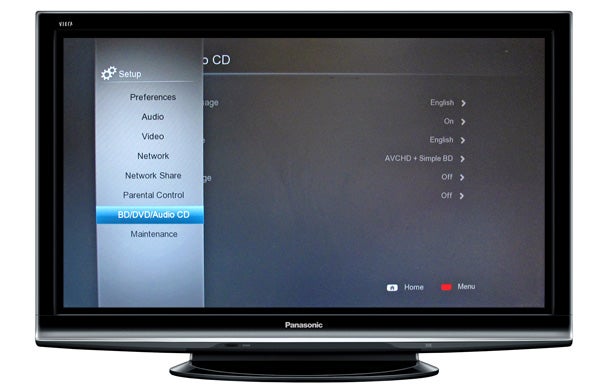
On that point, the Popcorn Hour C-300 also supports Bit-torrent and Usenet downloads, plus NAS over SMB, NFS and FTP. Load the box up with a 2TB hard drive and it’s a piracy powerhouse – or a lovely home for all those – err – perfectly legal bit-torrents of… your cousin’s wedding perhaps.
App Store
The Popcorn Hour C-300 comes with its own “app store”, which features portals to other online content, as well as the usual social networking gubbins and a couple of extremely basic games. It sounds de rigeur, but these portals are nothing new to media players, and were available in previous Popcorn Hour boxes.
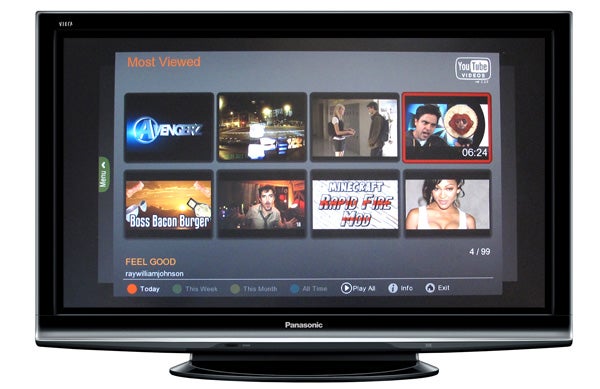
The YouTube app in action
App selection is downright poor. With 60-odd to choose from, the numbers may sound good enough, but all the most important picks are missing. You have Twitter, Facebook and YouTube, but Netflix, LoveFilm, iPlayer, 4OD, iTV Player, Blinkbox, Spotify and – well let’s just stop there because this is getting depressing – are all missing. Other channels are bitty portals to web channels only small numbers of people will be interested in.
Value
Missing out on every single staple streaming service means the Popcorn Hour C-300 is of very little interest to anyone willing to pay to download or pay to stream content. If you want to consume a mixture of downloaded and streamed content, it just doesn’t have the app support. And when the front display is a basic execution of a concept that itself feels a little dated, most hardcore downloaders will be happy with one of Popcorn Hour’s cheaper models.
Verdict
The Popcorn Hour C-300 media box can play just about any video or audio file you have. From this perspective at least, it’s a success. However, when it lacks every video streaming service popular in the UK aside from YouTube, is extremely expensive compared with its rivals and still has an interface that feels a little bolted together, it doesn’t warrant the price.
Trusted Score
Score in detail
-
Value 5
-
Features 7
-
Performance 6
-
Design 7


